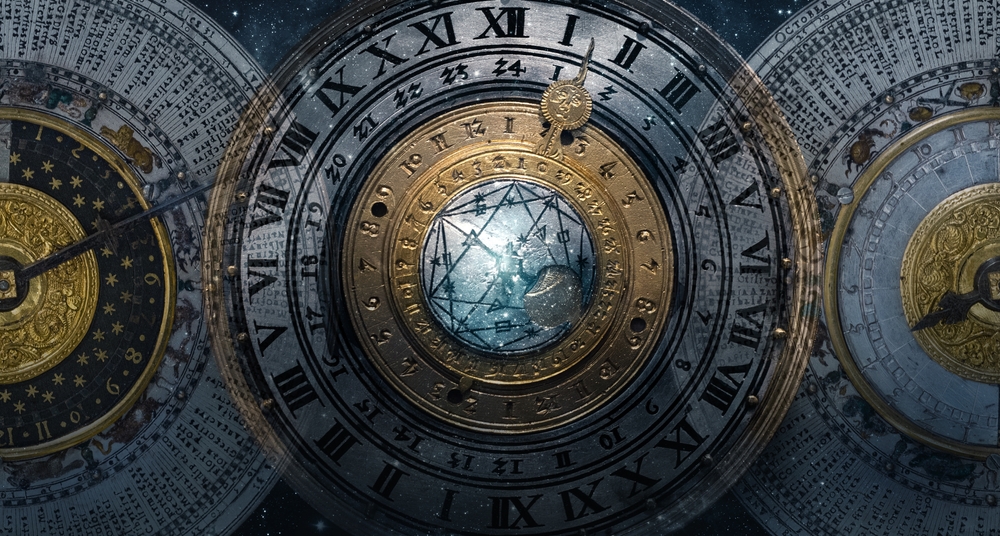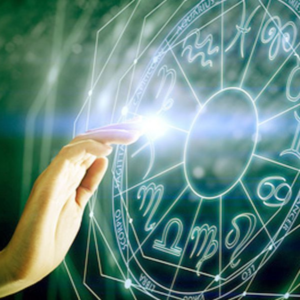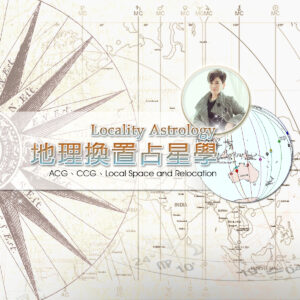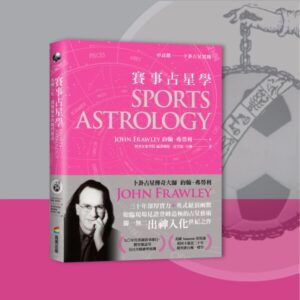〈前一集〉
Neptune (discovered 1846)|海王星(在一八四六年發現)
許多天王星的解釋方法應用於之後發現的海王星和冥王星,大大加速了描繪新行星的過程。占星界很大部分的人已被說服天王星的作用,因此也相信用來推論其象徵意義的方法。然而,在先前提及七項天王星象徵意義的來源中(詳見第四集),只有三項能勉強用來識別海王星,即神話、神智學說,以及對占星系統的誤解。
Early References|早期參考資料
早期的參考資料很少;曆書僅印製了它的符號。在已調查的曆書中,沒有發現以海王星為主題的相關資訊,只有當它與其他行星有相位時,才有些許的詮釋,但都很籠統。到了一八六五年,已提供海王星的符號,但別無其他資訊;和先前一樣,關於大部分海王星象徵意義的資訊,都是由十九世紀末和二十世紀初的神智學占星家所提供。97從他們的出版作品可以明確得知,海王星比天王星更容易造成問題,而且如後所示,問題從未被完全地解決。
Discovery Chart|海王星的發現盤
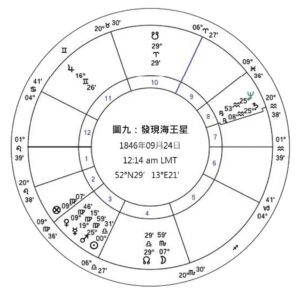
上圖是海王星的發現盤。如同天王星被發現時的位置一樣,海王星並不在角宮,而是位在第八宮。天王星被發現時,和凶星火星及土星形成對分相,海王星則是和大凶星土星緊密合相。儘管,土星位在自己守護的水瓶座,但位置不佳,而且逆行。有少量證據顯示,過去的占星家在開始描繪海王星時,將土星的象徵意義納入考量。天王星和海王星都被視為凶星,直到神智學的說法被採用。98事實上,很少人關注海王星的發現盤:
我們無需深入研究發現海王星的歷史,只要注意它是在一八四六年九月二十三日晚上在柏林被發現的,……99
這段陳述並未提供合理的理由。鑑於天王星的發現盤構成了象徵意義的基礎,提供理由是必要的。更確切地說,天王星現今被視為與爆炸及突然的災難有關,這依舊是援引它擁有火星和土星的性質。
Astronomical Characteristics|天文特徵
幾乎沒有象徵意義取自海王星的天文特徵。天王星因軌道偏離審註1而被描述為古怪,因此無法重複使用相同的象徵意義。海王星與地球,甚至與天王星的距離,阻礙了天文學家查明更多相關資訊的能力,占星家因而得出它很神祕的象徵意義。
Political Events|政治事件
一八四○年代社會主義的興起是海王星與「為團體利益自我犧牲」相關聯的根源,當然也包括社會主義本身,並延伸至理想主義、慈善行為與機構。再次地,占星家忽略了發展的脈絡,將這動向單獨地且直接地與海王星的發現作連結。現代社會主義源於工業革命,而工業革命本身被連結到天王星。占星界似乎沒有注意到這個悖論。
缺乏與海王星相關的重大政治事件被歸因於非政治的性質。欠缺政治性的關聯,進而形塑了非政治的象徵意義。100
Scientific Advances|科學的進展
鮮有與海王星相關的科學進展,但首度使用乙醚作為全身麻醉劑(一八四六年)的示範則被連結到海王星,因而延伸出「藥物」,尤其是麻醉劑和成癮性藥物。視背景而定,這些事項通常與土星有關,尤其是毒素,101例如,大麻與土星有關。不過,每顆行星根據其性質主管不同的毒物和藥物:木星主管用於止咳合劑的甘草;太陽主管用於治療眼疾的小米草(明亮草)。
占星文獻中有個少見的關聯,得以稍作進一步延伸。將「運輸用的蒸氣動力整合」歸屬於海王星102,某程度將海王星與該時期的運輸革命做了連結。儘管過去並未提及「蒸汽動力」,但是當「運輸」已經和天王星作關聯時,這種說法就令人費解。
Poseidon Myth|波賽頓的神話
由於缺乏其他資訊,海神波賽頓的神話就成了被強調的重點。這般資訊不足似乎並未引起太多關注和評論。沒有證據顯示這樣的推論方法曾經拿來與導出天王星象徵意義的方法作比較,這樣的不一致性似乎被忽略了。
天文學家依循慣例將這顆新行星命名為涅普頓(Neptune,中譯:海王星),而占星家則從波賽頓(Poseidon)的神話中尋找更多線索。克洛諾斯的另一個兒子波賽頓統治著海洋,因此海王星成為主管海洋萬物的行星。在占星家努力為這顆太陽系新成員進行說明時,它的管轄範圍也延伸至所有的液體,這在過去是由月亮所管轄。正如我們將看到的,金星的象徵意義也受到了掠奪。
對於那些占星家來說,波賽頓的海洋成了人類的深層心靈和情感,因此,海王星也與直覺、靈性或通靈能力相關,代表著各種的神祕主義。
Theosophical Doctrine|神智學的教導
「八度」的原則被延伸至海王星。如果天王星是水星的高八度,那麼按照順序,海王星就是金星的高八度。酒精、愛情、藝術、音樂、詩歌、藝術追求,包括攝影、電影藝術、時尚、想像力,這些都從金星的管轄範圍被移除了。
從早期出版的作品中,我們可以透過海王星的作用來辨識其不確定性:
海王星……整體而言,對地球及其居民僅有微弱的影響。對於從外部誘發通靈傾向無法控制的未開發靈媒(譯註:通稱具敏感體質的人),以及那些容易著迷或意志力薄弱的人,總是受制於不斷變化的印象,就某種意義而言,隸屬海王星的範疇,而在靈性上極為進化的人也是。103……但這必須花上很多年,才能制定充分的列表,為海王星的振動提供可靠的意見。104
在對天王星和海王星類型的物理性質進行詳述和說明後,作者發表了以下評論:
圖示的天王星和海王星類型中,想像力必須發揮重要的作用,因為在我們目前的進化階段中仍然缺乏這些類型。105
不僅是虛構的象徵意義,而且毫無疑問地,「缺乏這些類型」是因為海王星根本沒有這類的象徵意義,因此,所謂的「海王星類型」也許根本不存在。
人類的三種階級主題重新被用來解釋他們詮釋時的失敗。106再次地,並沒有說明該如何辨識誰會如預測般回應和不回應海王星的人。值得注意的是,海王星可以是極為邪惡的,或是「高度靈性的」,因此,就如同天王星一樣,其象徵意義的織網被廣泛地延伸。107他建議學習者「海王星的影響力完全視命主回應其振動的能力而定」。108如果命主並未展現出海王星影響力的效應,我們必須假設他或她被扔進了「下層階級」──一個糟糕的建議。在接下來的段落,我們找到了對這些新行星做出反應的具體參考。與稍早時期不同,這種「進化」的類型已經變得沒那麼神格化了:
那些能夠對它們極高振動做出反應的人,天王星和海王星(可能還包括冥王星)意味著更有修養的人類類型。109
我們可以假設,在已經提及的占星家和神智學家當中,已找到了回應天王星較高振動類型的人。難以想像會有大量客戶反駁這樣的描述。
開啟接受天王星錯誤描繪的先例之後,其過程仍在海王星持續著──未來的占星家將解開其象徵意義之謎。儘管他們的謹慎足以暗示錯誤的可能,卻依舊對新加入的行星詳盡地大書特書。110一再重複作出這些備註,卻似乎從未能阻止任何人在相關主題上喋喋不休。
通靈已被(譯註:被神智學家)認可為有效的研究手段(招魂術的興起與海王星的發現有關),因此有必要探索海王星關於「模糊」的名聲。這種象徵意義就像其他一樣,持續至今,從中又擴展出更多的意義,例如困惑、含糊、謊言、欺騙、混亂、錯誤、健忘等等,這些都是從這一詮釋中衍生而來。在本論文已探索的任何領域都找不到相關來源;它與海王星的物理特徵、神話或科學都無關。它的來源坐實了神智學占星家所採用的「科學」研究方法,其可疑和膚淺之處。
「從水晶中靈視,海王星看起來像模糊的電漿體。」111
接著,作者根據這樣的啟示繼續描繪海王星,這種描述也一直持續至今,未見一絲早期崇高的科學理想。儘管部分占星家意識到必須採取更嚴格的方法,但他們仍將相同的象徵意義向讀者們展示和推廣。112
Misunderstanding of the Astrological System|對占星系統的誤解
緊隨著天王星的模式,海王星仰賴波賽頓神話而代表多水的行星,進而成為雙魚座(水象星座且為金星的旺位)的主星或共同主星。這被作為是一個系統:
「行星的旺位似乎是其八度表達的宮位。」113
在發現冥王星時,這是另一個沒有根據而受到擱置的理論。
一再出現星座與宮位具共同意義的錯誤。十二宮(雙魚座是第十二個的星座)的意涵被賦予了海王星,例如,醫院歸屬於海王星:他們從十二宮與監獄和囚禁的關聯推斷出這一點。114海王星隨後成為禁閉、退隱和流放場所的主管星。從雙魚座的管轄範圍延伸,雙魚座和十二宮都逐漸取得了如神祕主義、通靈、夢和幻象等事物的主管權。
Conclusion|結論
由此混合成一顆神祕的行星,唯有最細膩的人方能體驗它未知的效應。它的水象與潛意識心靈的連結帶來極大的自由度,命主可能無法意識到它的影響力,因此有更多人可以被歸類到它的象徵意義底下。單薄的連結和聯想逐漸積累,且從未改變,即使倡導者已經建議謹慎採用,如今卻依舊維持和當時一樣的象徵意義,代表著當今占星家的共識。
Pluto (discovered 1930)|冥王星(在一九三○年發現)
隨著冥王星的發現,所有的謹慎和傳統都被拋諸腦後,各個作者都急於發表他們的理論。他們立即發表關於冥王星影響力的詳盡詮釋和意見,許多關於守護星座和基本管轄範圍的觀點也都迅速確立。之前堅稱實踐和經驗才是唯一真正衡量有效性的標準,此時,也被擱置一旁。
西方占星傳統的結構在此時也一再被打破。如我們所見,人們預計會發現更多的行星,神智學占星家也已經制定了他們的應變計劃:新的行星將補足占星學缺失的謎團,而依舊忽略正是這些行星帶來分裂的原因。當承諾的啟示未能實現時,他們採用既定的藉口:命主的自由意志、缺乏能夠回應冥王星影響力的先進人類,以及行星本身固有的神秘性。
評估冥王星特徵所依循的程序,可依天王星和海王星的相同方式來進行分類。這些分類的要點以更快的速度被混雜在一起,並延伸到比過去更廣泛的範圍。這樣的混雜讓人難以區分其中的成分,並因心理學術語的使用而加劇情況的複雜性。
天王星與海王星的象徵意義已成定局,沒理由再懷疑它們在占星系統中的位置,而冥王星也是一樣。
Early References|早期參考資料
占星家不待片刻地發表他們對冥王星的意見;儘管大多數的作者在他們長篇論述的序言中提出了需謹慎的建言。從早期參考資料中選擇這份文獻,是因為作者處理冥王星的方式較為全面;布瑞恩胡博納(Brunhubner)在整本書中幾乎毫無保留地致力闡述他的論點。雖然這個版本直到一九六六年才出版,但作者的序言是在一九三四年寫下。此外,他提到自己在一九三三年首度公開他的「觀察」,同時明確表示自己是「第一位向大眾公開對新行星進行全面性研究的人」。115
對於如此倉促是否明智並無明顯的質疑,因為再次地,就他們的觀點而言,即使他們的發現可能有瑕疵,但一般性原則是沒有問題的,未來的占星家會糾正任何錯誤,並為這些早期觀察進行補充。
一九三七年,一位作者承認對冥王星的所知甚少,暗示它的地位僅是引發人們「思索的興趣」。稍後他又重複了這個論點,然而,這般小心謹慎並未妨礙他自信地作出以下論述:
一顆行動之星,代表試圖擺脫海王星積累的昏沉—以及渴望從海王星強加的束縛中解脫……因此他的影響力是爆裂的,這解釋了它與疾病和意外的關聯,以及它一方面出現在音樂家和具靈性傾向的星盤上,另一方面也出現在罪犯星盤上的意義。它本質上具有爆發力,暗示著自由和爆炸性的行動。116
他對於這些陳述的自信與先前的謹慎相矛盾,清楚表明神智學說是冥王星象徵意義的重要基礎,至於如何得出這些結論,卻沒有解釋。同一作者提供超過六頁與三王星相關的觀察結果,卻只有三頁專門論述其他七顆行星。這樣的態度顯示出一種後來的作者也一直遵循的模式。
在研究冥王星被發現之後的參考資料時,必須留意到,一九三○年之前的資料也對其象徵意義具有顯著的影響。如前所述,占星家和天文學家假設未來還會發現其他行星,因此,對神智學占星家來說,這已經成了對十二個黃道星座(不同的)守護行星的追尋,特別是兩位作者都認為他們已經實現了此一目標,並在冥王星被發現之前發表了他們的發現。117兩人都詳細說明他們各自的構想,其中包含火星和木星之間的小行星,以及假定的行星。其中一人將巨蟹座的星座主管權給予了假設的冥王星,另一人則分配給天蠍座。這裡應理解的是,儘管這些占星家預期會發現更多的行星,但提及冥王星的假說並不能被視為發現冥王星的預測。除此之外,他們也使用祝融星(Vulcan)和忽女星(Dido)等,並指出艾倫.里奧如何費盡心思區分「羅威爾的冥王星」(Lowell-Pluto)和「韋米斯的冥王星」(Wemyss-Pluto)。韋米斯自己在一九四○年代末期出版《生命之輪或科學占星》(Wheel of Life or Scientific Astrology)最後一冊時也堅守那樣的立場。118
宮位和星座缺乏對比,令人感到困惑。我們可以觀察到冥王星與八宮關聯的開始,後者被描述為再生和進步。天蠍座被形容與權力、進步、再生和解放有關,而假設的冥王星則像是「負面的火星」。代表天蠍座「基調」的「正義」則取自冥王星和冥界的神話。119同一位作者提供了許多星盤案例,卻從未用假設的行星和小行星探究她自己的理論。
以下顯示假設的冥王星所被賦予的象徵意義,與當今占星家所使用的大致相同。
Discovery Chart |冥王星的發現盤
我們無法找到關於這張星盤的資料來源,但位於角宮的火星和月亮,似乎暗示著冥王星取代火星成為天蠍座主星之後的象徵意義,並呈現出通常與月亮相關的水象性質。我們也可以考慮太陽和金星位在八宮的位置,對冥王星來說也是隱蔽的,可能為後者的象徵意義帶來影響。太陽是天空中最強大的天體,透過核反應散發出巨大的力量、熱和能源;然而這一切原則都被賦予了冥王星──這顆距離太陽最遙遠,光線最少的行星。這顆行星也與性能力有關,而在這張星盤中,我們發現金星入旺並與太陽合相。
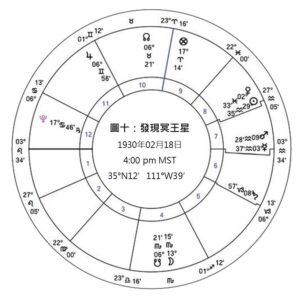
Astronomical Characteristics|天文特徵
幾乎沒有什麼可說是反映到冥王星的象徵意義。作為太陽系中距離最遙遠的行星,它仍是我們所知甚少的行星。新的發現總被貼上「奧妙」或「神祕」的標籤,而冥王星更是如此。
Political Events|政治事件
第一次世界大戰(一九一四至一九一八年)後,政局的變化對隨後而來的一切帶來了極大的影響。如此重大的變化包括一九一九年的凡爾賽條約、一九二○年甘地執掌印度國大黨、一九二一年中國共產黨和一九二二年蘇聯的成立、一九二三年鄂圖曼帝國的告終(自一三○○年開始存在),以及一九二四年史達林接任列寧的職位。每個事件都對世界史造成沉重的負擔,至今仍可見到這些衝擊所帶來的影響。
然而,冥王星通常只和一九二九年至一九三三年的大蕭條有關,後者導致了一九三○年的世界經濟大蕭條,並且與納粹主義(以及其他的極端政治立場)、希特勒的興起直接相關,而冥王星也與一九三九年的第二次世界大戰有關。
隨著將冥王星與核分裂作了連結,它也被連結到核武和戰爭;據此,以及它與第二次世界大戰的關聯,廢除了火星對這些事務的主管權。這種主管權的變更,在過去和現在都是合理的,說是因為有不同類型的戰爭:有的戰爭是殺人,有的卻是「滅絕」。120
海王星的下一顆外行星是冥王星,因此這顆行星顯然必須承接火星的八度表達。它的主要原則是滅絕,即毀滅狀態不斷地延續。在戰爭中,房屋或建築物遭受破壞,但瓦礫仍然存在,隨著時間受到風雨摧殘,瓦礫會變成更小的碎片,並最終變成粉末。接著風從天空的四面八方吹來,將粉末吹散,最後連一點微粒都沒有留下。這是解體,最終成了滅絕,即一無所有,這就是冥王星這顆行星「長期」振動帶來的效應,……121
儘管惠特曼(Whitman)探討的是物質的長期分解,但此一作用已擴展到包括大規模的破壞,就神智學家看來,這是火星所無法涵蓋的事件。
冥王星的發現也與一九三○年左右美國經常發生的勒索詐騙事件相關,這種勒索詐騙與一九二○年至一九三三年的禁酒時期有關,當時美國禁止飲酒。然而最早是在一八四六年通過相關州法,推動全國禁酒運動的勢力逐漸升高,在一九二○年頒布全國法令時達到最高峰。所以,這樣的趨勢早在發現冥王星之前就開始了。
Scientific Advances|科學的進展
占星家仍然渴望被體制所接納,正如他們熱衷於將冥王星納入系統。他們熱切地將科學與技術的發現,與冥王星的發現相連結,就像他們在更早的發現中所做的那樣。但如同發現海王星的時期,這樣的關聯是不足的,至少,就大眾的意識和興趣而言是如此。這是他們的標準未能適當處理象徵意義歸屬問題的另一個例子。
冥王星與核能或原子能有關,說是主管核武器。原子哲學的起源可追溯至西元前五世紀的古希臘;德謨克利特(Democritus of Abdera)將物質的組成部分稱為「原子」(字面意思是:「不可分割」)。現代原子理論奠基於道爾頓(Dalton)及其他十九世紀早期學者的研究成果,而相關研究在整個十九世紀也有更深入的進展。如同將科學進展歸因於天王星和海王星的時候一樣,其關鍵的發展過程受到了忽略,唯一引起關注的是一九三二年發現中子,以及原子的分裂。
Pluto Myth|普魯托的神話
人們為這新發現的行星提議了不少的名字,但是,名稱一經確定,就為占星家帶來了麻煩;儘管他們已經準備好接受非占星家對行星的命名是有意義的巧合。如先前提過(請見第一集),冥王星的名稱已經被用過了。
不幸的是,天文學家給它取了一個不適當的名稱:冥王星,這個名字已被賦予另一顆假設的行星(守護巨蟹)。為避免混淆,占星界必須將最初的冥王星稱為韋米斯冥王星,將羅威爾的行星稱為羅威爾冥王星。122
然而,這卻未能防止混淆,「韋米斯冥王星」的象徵意義,包括它對巨蟹座的主管權,大多都被轉讓給新發現的行星。
隨著越來越多心理學術語,使他們對於天王星和海王星的神話詮釋受到了確立並顯得合宜,因此,雖然冥王星的命名是個不幸的偶然,但人們還是熱衷應用冥神的神話。這位神祇的名字實際上是黑帝斯(Hades),他統治著塔爾塔羅斯(Tartarus,即地獄的代名詞)。由於懼怕他的憤怒和報復,人們通常用綽號稱呼他:普魯托(Pluto),意指世俗的財富,123因而取得與巨大財富、企業財富、礦產和地下活動的關聯。所以,勒索詐騙和冥王星的連結是透過犯罪的「地下世界」而獲得概念上的支持。
Theosophical Doctrine|神智學的教導
如前所示,堅持「八度表達」的原則仍持續銘刻在行星的象徵意義上。三王星的緩慢運行證實了它們在更大的世界發揮作用:水星代表一般的思想力量,而天王星代表「具個人特色」的思想力量;金星代表一般的愛,而海王星代表「普世」的愛;火星代表毀滅,冥王星代表徹底毀滅(這就是「滅絕」的意思)。124
進一步評論也只能重複那些天王星和海王星的部分,唯一明顯的是個別做出的改變,而且是基於神智學「八度表達」的變化。
Misunderstanding of the Astrological System|對占星系統的誤解
在這個標題下,我們可以納入冥王星與再生的關聯,因為這顯然是假設冥王星(韋米斯冥王星)的特質,而如前所示,這從未打算用來敘述新發現的行星。
滅絕和死亡的原則分別取自火星和土星,重生的概念同樣被賦予冥王星,而這向來與太陽有關;後者在天空運行,在每個黎明重生。「帶來光明」是另一個經常用來解釋冥王星作用的句子,然而這樣的事件是通過太陽和月亮的良好相位(通常是三分相)才能實現—即發光體。如果沒有透過太陽,就不會有其他的光照,無論是實際狀況或是隱喻的意義。125
一旦宣告冥王星是天蠍座的守護星,八宮事務就被賦予了關聯,因為天蠍座是第八個星座。126
在這方面,應提及冥王星的詞zeitgeist,它代表與土星外行星同一組所連結的時代精神。神智學家用其緩慢的運行來表明它們的「世代」效應。幾位作者表示它們對個人的影響不大,但這並沒有減少他們用於描繪個人的細節。127我們也許可以將此視為他們試圖從個人星盤分析中移除這些行星;如果它們的影響力是世代性的,那就沒什麼好拿來形容個人了。這樣的立場可以視作一種妥協:這些行星未能如描繪中所預期的,但是又無法從系統中移除,因此他們創造了另一個「豁免條款」。
Conclusion|結論
值得注意的是,隨著占星家關注的行星數量越來越多,就有更大的自由度去拆解原來的架構。本文前半部分解釋了占星學的基本原理(請見第三集)。該架構顯然是圍繞著太陽及其明顯的天文和物理特徵所建立,然而,如同先前說明,在對古代技術最後一波的攻擊中,竟說冥王星比太陽更強大。以宗教語彙來說,即冥王星取代了大多數西方文化中由太陽所代表的上帝。
唯有在發現三王星時期的「科學」氛圍下,這種褻瀆行為才會受到支持,甚至是歡迎。我們也注意到,同樣的,沒有人對其世俗性質提出挑戰,只見想讓新系統就位的企圖。
Comparisons|比較
英國占星學院(Faculty of Astrological Studies)一九五四年至一九六九年的院長瑪格麗特·霍恩(Margaret Hone)對占星學界帶來了重大影響,她的話值得研究:
……(關於新行星的主管權)尚未做出明確決定,但在此提供即將採納的想法。這些新行星可能在意義上體現了廣泛的原則,它們不該如傳統的方式那樣被侷限於任何的主管權。
其中一種說法是,它們每顆行星都是較早已知行星的「高八度」,彷彿它們提升了思想,開闊了人類的視野。128
這本書於一九五一年首度出版,經歷了四次修訂,但這位占星教育的忠實擁護者仍不確定新行星的象徵意義。她的部分學生和讀者僅能依靠揣測,但她的書截至一九八○年為止共重印十五次,其中一年(一九六九年)有兩次重印。如同她的前輩們,這樣的疑慮並沒有妨礙她一再複述三王星的象徵意義,而這些象徵意義也被她成千上萬的讀者和學生們所吸收。
以下的管轄權列表取自二十世紀末期的各種作品,方便與早期作者規範的管轄權進行比較。129現代的象徵意義列於每顆行星下方,並對應到假定的來源。如第一欄所示,儘管「八度表達」的理論來自神智學說,但卻因為對占星系統的誤解,進一步發展成可行的方法,所以納入下一個標題的表格中。在該標題下,還包括了象徵意義的來源,無論是行星、宮位還是星座。
隨著心理學在占星詮釋中變得顯著,語言的變化是顯而易見的,但無論是用「更高層次的群體直覺」還是「高八度」來表達,它的含義和來源都是相同的。130這三顆新行星中的每一顆,某程度都與無意識思維有關,而這衍生自它們所謂無法穿透的性質。那個無法穿透的梗,來自於神智學占星家無法為它們找到精確的詮釋,而這樣的狀況一直持續至今。
|
象徵意義來源 |
天王星的象徵意義 |
海王星的象徵意義 |
冥王星的象徵意義 |
|
發現盤 |
凶星 具火星和土星的性質 |
凶星 具土星性質 (亦參考第十二宮) |
凶星 具火星和月亮的性質 |
|
天文象徵 |
古怪 打破界限 突然的改變、不可預測 不尋常的人和事件 |
神祕 |
神祕 作為最外緣的行星:最終、萬物的盡頭。韋米斯冥王星:再生、開始和結束(太陽也是)、週期、循環、極端。 |
|
政治事件 |
革命與叛亂 推翻 個體性、獨立 社會改革 突然的改變、偏離、動盪 民主 |
社會意識、與慈善行為相關 理想主義 犧牲與自我犧牲 社會主義 |
法西斯主義、史達林主義 犯罪集團、國際恐怖主義
|
|
科學進展 |
新奇、偏離 天才與獨特 十世紀的發明和二十世紀的發展 |
麻醉劑,因此也包括逃避現實和催眠 |
原子動力、核分裂和融合 |
|
神話 |
叛亂、推翻 冒險 分裂 |
想像力、情緒 幻想與神話,因此也包括逃避現實和錯覺 夢想、嚮往 海洋 |
超越 清除 更新 再生 揭露 暴力的、災難性的、爆發的 |
|
神智學說 |
天才、獨特、偏離 不可預測和分裂 神祕學 (集體)無意識 |
通靈 神祕的事物、看不見的事物、神祕主義 聖潔和靈性 精煉 朦朧 印象性 (集體)無意識 更高層次的群體直覺 |
(集體)無意識 深層心理學 時代精神 |
|
對占星學的誤解 (包含八度表達的理論。該象徵意義的原始關聯顯示於括弧中。) |
天才(水星) 獨創性(水星) 朋友、熟人,並延伸至團體(第十一宮) 教育、知識傳播(月亮和水星) 固執(水瓶座) |
溶解(月亮) 浪漫與愛情(金星) 藝術、音樂、美、表演 酒精(月亮) 藥物(各種行星) 感官享受(金星) |
轉化;週期;誕生、死亡和重生、循環、力量(太陽) 富有與豐饒(木星) 共同財務、其他人的金錢、意志、遺產(第八宮) 稅務與稅務員(第十一宮為徵稅機關的第二宮) 死亡(第八宮和土星) 性交(金星) 任何隱藏,尤其是地下的事物(第四宮、土星和焦傷) 任何與生殖器官相關的事物(天蠍座和第八宮) 外科手術、刀、屠宰、工程和機械技能、徒手格鬥(火星) |
Conclusion|結論
三王星象徵意義的分析,在某些情況下,因倡導者缺乏邏輯的方法而受挫。這種表面的象徵意義取自日趨虛假和膚淺的基礎。個人意見、學說與宣傳的動機混淆了各種問題,甚至,倡導者本身並不清楚他們是如何或應該如何取得這些行星的性質和特性。新行星的象徵意義主要來自一個由錯誤和宣傳所構成的狹隘基礎。
神話也日漸受到依賴,並擴展成榮格心理學的原型。為行星命名的人決定了這些神話,但這很少引起占星家的關注;往後幾代的占星家已接受了這是有意義的巧合。證據明確顯示,神智學家是依據當時的重大事件和氛圍來設定主題,然而,即使氛圍和趨勢已經有所變化,象徵意義至今依然沒有改變。
新行星的象徵意義並不符合占星家自己的「科學」標準。應用於占星盤時,這些行星並沒有產生預期的事件或影響。如果這曾經引發疑慮,那麼在他們的著作中並不明顯。他們確信理論是正確的,只是在實踐上無法立即跟上,需要進一步實驗來加以改正,這留待未來的占星家來證明他們的理論。但在隨後的幾年裡,象徵意義幾乎沒有改變,證明並未出現。
神智學家提出的「密義」占星學,被宣稱優於任何其他系統或原理,從這裡,再加上混亂的占星原則和技術,像里奧這樣的占星家,其動機已經昭然若揭。顯然地,占星學被蓄意地、故意地轉換成符合神智學的學說,這種對占星系統的轉換幾乎是在沒有考慮後果的情況下進行。他們相信自己的行為是廉潔的,這也助長了他們的動力,甚至認為任何事物都會比舊系統要好。該學說被視為真理,並持續構成今日占星實踐的主要部分,尤其是三王星的部分。他們的確信和錯誤讓這古老而神聖的科學向不合理的過度行為敞開,催生了這調換兒的系統(the Changeling System)審註2。
在試圖將占星學與個人理念結合之前,必須先了解占星學本身的哲理,而且,在試圖對特定的時代趨勢保持中立時,也必須先解決主觀所造成的難題。然而,從所探討的時期來看,這兩項所帶來的影響都是不成比例的,而且,幾乎沒有採取任何措施來修正平衡。
基於上述各點的分析,已證明這些行星特質的基礎是不可靠的,神智學占星家被迫退回到防守的姿態。就占星學而言,無論透過經驗、統計證據或其他方面,都沒能證實任何一點。儘管如此,他們成就的仍不容小覷:他們說服了夠多具影響力的作者相信他們的見解是正確的。這些意見已經確立,從成千上萬的學生受其教導便可證明。
當今的占星家重複並複製神智學占星家所制定的象徵意義。如果占星家不需要預測,實際上,經常被教導不要預測,那麼就不需要準確性;同樣地,就占星學的角度來說,行星也不需要以可預測的方式運作。說是我們不可能理解和熟悉新行星的運作方式,因為它們是「世代」行星,或說它們影響的是我們潛意識更深層的區域,因此,不僅是占星家無法預測它們的作用,命主也無法意識到這樣的行動;換句話說,占星學界在這些行星象徵意義的方面,並沒有超越前人。在發現這些行星的初期,只有少部分人反對它們的占星意義,到了現在二十一世紀,情況依舊不變。
這些作者也受到必須推廣占星學以及希望讓科學界刮目相看等焦慮所驅使,儘管前者已經實現,但學術界依舊和以往一樣難以接受占星學,原因也大致相同。象徵意義建立在最薄弱的基礎上,當它在實踐中失敗時,象徵意義就會配合這樣的失敗而改變。科學機構對於占星研究沒有留下好印象並不令人驚訝,因為這些論點的可信度只對受到神智學占星術訓練的占星家具有吸引力,而他們目前佔多數。
他們經常舉例證明三王星在預測方面的效力,更不用說那些經常使用個人覺察來舉證的人。然而,這樣的證明來自於那些最堅信其象徵意義的占星家:個人證明也來自於同樣的占星家。此外,他們接受的是現代學派的教育,如前所示,即奠基在神智學系統的占星學,因此,幾乎無法從這樣的來源獲得新的證明。
任何星盤,或說任何類型的星盤,其象徵意義是多方面的,辨識「活躍」的行星需要占星家少見的訓練和紀律。占星家有各式各樣的選擇,因此很容易將一個錯認成另一個。直覺也可能是基於錯誤的根據卻還能做出成功預測的因素之一。然而,在應用嚴謹的方法時,新行星是多餘的。它們無法提供新的資訊,因為根本沒有新的資訊可以提供。
對於這些保留至今象徵意義的占星方法、正直或真理,占星家應擺脫將其視為絕對的想法。這些意義之所以保留至今,是因為倡導者可以從這樣的行動中獲益,而他們具有壓倒性的人數優勢和影響力。當這些象徵意義無法成功運用於實務時,很少人願意正視這來源的混亂,一層層地辯解,直到現今的占星家不再對符合邏輯的方法抱有期待。如今佔主導地位的是新時代的觀點,而且一如以往地反對邏輯和常識。如果象徵意義不合理,或是無法應用於實務中,便說占星師應更注意這些意義所設定的靈性模式。
這讓讀者感到難以置信與困惑。大量的不準確、不合邏輯、膚淺,以及藉宣傳的便利抨擊知識分子。那時和現在一樣,這種不合常規的觀點是「非占星學」的觀點,或是缺乏對占星學的理解,而且近似異端。據稱除了最先進的靈魂,有些三王星相關的特質是「不可知的」。然而,占星學的構思就是一種理解神聖意志的方法,占星學就是要讓人「知曉」,聲稱我們不該知道只是無知和佯裝學問的藉口。
我們必須回到原點,因為最重要的問題仍未獲得解答:三王星在占星學具有重要意義嗎?甚至可以說,它們必須有重要的占星意義嗎?
(終)
審註1:天王星被發現之後,一八二一年法國天文學家亞歷克西·布瓦爾(Alexis Bouvard)出版天王星的軌道表,但隨後的觀測結果,發現它的運行軌道總是偏離牛頓萬有引力定律所推算的結果。詳見維基百科。
審註2:「調換兒」(the Changeling)是西歐民俗傳說,通指被妖精換走了孩子,類似「狸貓換太子」。詳見維基百科。
Uranus, Neptune, and Pluto:
An Investigation into the Sources of their Symbolism Part 05 (End)
Sue Ward (Written 2002)
Neptune (discovered 1846)
Much that has been explained about Uranus, applies to the subsequent discoveries of Neptune and Pluto. The process of delineating new planets, though, was greatly accelerated. A significant proportion of the astrological community had convinced itself of the action of Uranus and, thus, of their methods of deducing its symbolism. However, of the seven general sources for Uranus’s symbolism, mentioned earlier, only three were identified for Neptune to any degree, those of myth, Theosophical doctrine, and astrological misunderstanding.
Early References
There are few early references; the almanacs simply produced its glyph. Of those almanacs that were examined, nothing could be found relating to Neptune alone. Some interpretations were provided when it was connected with other planets, but only in general terms. By 1865, Neptune’s glyph was being provided, but nothing more is mentioned about it; the greater part of the symbolic information about Neptune is obtained from Theosophist astrologers of the later nineteenth and early twentieth centuries as before.97 It is clear from their published works that Neptune was more problematic than Uranus had been, and as will be shown, this was never fully resolved.
Discovery Chart
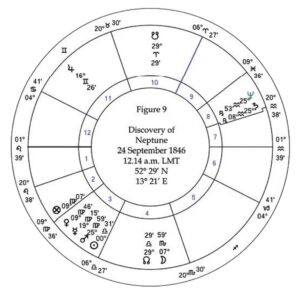
The above figure charts the discovery of Neptune. As with the position of Uranus at the time of its discovery, Neptune is not angular, being in the 8th house. As Uranus was placed in opposition with the malefics Mars and Saturn at its discovery, Neptune is closely conjunct the Greater Malefic, Saturn. Although, Saturn is in its own sign of Aquarius, it is badly placed and retrograde. There is a little evidence to suggest that the astrologers considered Saturn’s symbolism as they began to delineate Neptune, although both Uranus and Neptune were considered malefic until Theosophical doctrine was brought to bear.98 In fact, the discovery chart was given scant attention:
We need not traverse the history of the discovery of Neptune, except to note that it was found in Berlin on the night of September 23rd, 1846,…99
No justification is offered for this statement and, given that the chart of the discovery of Uranus formed the basis of its symbolism, such justification is necessary. Indeed, Uranus is now associated with explosions and sudden catastrophes which still draws on its alleged Mars-Saturn nature.
Astronomical Characteristics
There was little symbolism to be drawn from Neptune’s astronomical characteristics. Indeed, since Uranus had been described as eccentric because of the eccentricity of its orbit, this symbolism could not be re-used. Neptune’s distance from the Earth, and indeed from Uranus, obstructed the astronomers’ ability to discover much information about it; from this, astrologer’s drew its symbolism of mystery.
Political Events
The rise of socialism in the 1840s is the source of Neptune’s association with self-sacrifice for the good of the community, and, of course, socialism itself. From this was extrapolated idealism, charitable acts, and institutions. Once more, the astrologers ignored the developmental line, treating this movement as isolated and directly linked to Neptune’s discovery. Modern socialism has its roots in the Industrial Revolution, which was itself linked to Uranus. The astrological community appears not to have noticed the paradox.
The dearth of notable political events with which to associate Neptune has been attributed to its non-political nature, so the lack of political connections has produced an apolitical symbolism.100
Scientific Advances
There are few scientific advances associated with Neptune, although the first demonstration of the use of ether as a general anaesthetic (1846) is linked to it. Hence, associations with drugs, particularly narcotics and addictive drugs have been extended from that. These matters would usually be associated with Saturn depending on the context, particularly toxins.101 Hemp is associated with Saturn, for example. However, each planet has rulership over various drugs and medications according to their natures: Jupiter has rulership over liquorice which is used in mixtures for coughs; the Sun rules euphrasia (eye-bright), used for diseases of the eyes.
An association that is rarely seen in astrological literature takes this a little further and attributes ‘the consolidation of steam power for travel’ to Neptune,102 which goes some way to linking Neptune to the Transport Revolution of the period. It is difficult to understand this statement when transport had already been associated with Uranus, although steam power had not been mentioned.
Poseidon Myth
With the lack of other sources, emphasis was placed upon the myth of the god of the sea, Poseidon. This shortage of material appears to have caused little concern and raised no comment. There is no evidence of comparisons having been made with the methods used for deriving Uranus’s symbolism, and that inconsistency is seemingly overlooked.
Astronomers, following tradition, named the new planet Neptune, and astrologers looked to the myth of Poseidon for further clues. Another son of Cronos, Poseidon ruled over the sea, thus, the planet Neptune became ruler of all things maritime. This rulership was extended to include all liquids, formerly the dominion of the Moon, as the astrologers struggled for explanation of this new member of the solar system. As we shall see Venus was also plundered for its symbolism.
For those astrologers, the oceans of Poseidon became the depths of the human psyche and of their emotions. Hence, intuition and psychic or mediumistic abilities were associated with it, and Neptune represented all kinds of mysticism.
Theosophical Doctrine
The principle of ‘octaves’ was extended to Neptune. If Uranus was the higher octave of Mercury, then proceeding in order, Neptune would be the higher octave of Venus. Alcohol, love, art, music, poetry, artistic pursuits, and thus, photography, cinematography, fashion, imagination were all removed from the domain of Venus.
In the earlier published works, we can identify uncertainty with Neptune’s action:
Neptune,… has, on the whole, but a faint influence upon our earth and its inhabitants. The undeveloped psychic who is unable to control the mediumistic tendencies induced from without, and those who are easily obsessed or of very weak will, always subject to changing impressions, will in one sense come under Neptune as will also those who are very highly advanced psychically.103 … but many years must elapse before sufficient tabulation is made to warrant a reliable opinion concerning Neptune’s vibrations.104
After offering detailed descriptions and illustrations of the physicality of the Uranian and Neptunian types, the author makes the following comment:
In both the Uranian and Neptunian types as illustrated, imagination has had to play a prominent part, owing to the scarcity of these types at our present stage of evolution.105
Not only has symbolism been pretended, but there is never any question that the ‘scarcity of these types’ is because Neptune does not have any such symbolic meaning and, therefore that, ‘the Neptunian type’ might not, in fact, exist.
The subject of the three classes of humanity was re-applied in order to explain failures in delineation.106 Again, instruction on how to identify those who can respond to Neptune, as predicted, and those who cannot, is not forthcoming. It is noticeable that Neptune could be extremely malefic or ‘highly spiritual’, so, like Uranus, the symbolic net was spread widely.107 Students are advised that “Neptune’s influence depends entirely upon the native’s ability to respond to its vibrations“.108 If the native did not attest to the effects of Neptune’s influence, we must assume that he or she was cast into the ‘lower class’ – an unattractive proposition. A little later, we find specific reference to the type of person who would respond to these new planets. Unlike the slightly earlier period, this ‘advanced’ type has become less god-like:
To those who can respond to their very high vibrations, Uranus and Neptune (and probably Pluto) denote the more highly cultivated types of humanity.109
We might assume that this type was to be found among the astrologers and Theosophists already mentioned as responding to the higher vibration of Uranus. It is difficult to imagine that large numbers of clients would have disagreed with such a description.
Having established the precedent of accepting errors in delineation with Uranus, the process continued with Neptune. Future astrologers would solve the riddle of its symbolism and, although a great deal was written about this new addition, in detail, they were circumspect enough to suggest the possibility of error.110 These remarks were made repeatedly, but it seemed never to prevent anyone from verbosity on the subject.
Psychism having been accepted as a valid means of research (the rise of Spiritualism having been associated with the discovery of Neptune), it is necessary to explore Neptune’s reputation as ‘nebulous’. This symbolism has, like much of the rest, persisted to the present day and from it has been extended a great deal more. For example, confusion, mistiness, lying, cheating, muddle, error, forgetfulness, and so on all were born from this one interpretation. Its source cannot be found in any of the areas already explored by this paper; it does not relate to Neptune’s physical characteristics, or its myth, or science. Its source provides the clearest evidence of the dubious and superficial methods of so-called ‘scientific’ research employed by the Theosophist astrologers.
“Viewed clairvoyantly in the crystal, Neptune appears as a nebulous plasma.“111
The author then proceeds to delineate Neptune according to this revelation and it is a delineation which persists to this day. There is no trace of the lofty, scientific ideals of earlier days, and, although some astrologers recognized the need for a more rigorous approach, they, nonetheless, presented and promoted the same symbolism for these new planets to their readership.112
Misunderstanding of the Astrological System
The model of Uranus was closely adhered to. Neptune denoted a watery planet because of its reliance on the Poseidon myth, and would follow in order to become the ruler, or co-ruler of Pisces, a watery sign and the exaltation of Venus. This is treated as a system:
“it would appear that the exaltation of a planet is the house of its octave expression.“113
The error of the consignifications of signs and houses is repeated so that their associations of the 12th house (Pisces being the twelfth sign) was given to Neptune. For example, hospitals are attributed to Neptune: they had extrapolated that from the 12th house association with prisons and captivity.114 Neptune then became the ruler of places of confinement, retreat, and exile. From this was drawn its rulership of Pisces and from this, both Pisces and the 12th house accrued rulership of such things as mysticism, mediumship, dreams, and visions.
Conclusion
The resulting mixture was a planet of mystery, its effects unknown and not experienced by any but the most refined. Its watery connection to the unconscious mind gave maximum latitude since it might be that the native was unaware of its influence. Thus, many more people could be brought under its symbolism. The tenuous links and associations that were gathered have never been changed. The symbolism remains the same now as it was then, implying acceptance by present-day astrologers, even though its promoters advised caution.
Pluto (discovered 1930)
With this discovery all caution and convention was abandoned as various authors hastened to publish their theories. There was no delay in publishing detailed interpretations and opinions of Pluto’s influence, and a number of viewpoints about the sign it ruled and fundamental rulerships were put into place very quickly. Having previously maintained that practice and experience were the only true measures of validity, these, too, were put aside.
By this time, the structure of the western astrological tradition had been breached repeatedly. As we have seen, further planetary discoveries had been expected, and the Theosophist astrologers had made their contingency plans: new planets would complete the astrological jigsaw. That those same planets were the cause of those fractures remained unrecognized. When the promised revelation failed to materialize, they resorted to established excuses: the freewill of the native, the shortage of that advanced human being capable of responding to Pluto’s influences, and the inherent mysteriousness of the planet itself.
The procedures which were followed in assessing Pluto’s characteristics, can be categorized in the same way as with Uranus and Neptune. With the greater speed, the substance of those categories was mixed together and extended to a far greater degree than before. Such a mixture complicates any attempt to isolate its ingredients, and is exacerbated by the increased use of psychological jargon.
The die had been cast with Uranus and Neptune, there was no reason to doubt their places in the astrological scheme, nor was there with Pluto.
Early References
Astrologers wasted no time in publishing their opinions on Pluto; most authors, though, prefaced their long discourses with recommendations of caution. One of the earliest references has been chosen because of the comprehensive nature of its author’s treatment of Pluto. With few reservations, Brunhubner dedicates the entire book to his thesis. Although this edition was not published until 1966, the author’s preface is dated 1934. Moreover, he states that he first unveiled his ‘observations’ in 1933. He also makes it clear that he was the ‘first to give to the public a comprehensive work on the new planet.’115
Doubts about the wisdom of such haste are not apparent because in their view, again, although the detail of their findings might be flawed, the generalities were not. The astrologers of the future would correct any errors and supplement these early observations.
In 1937, one author admits that little is known about Pluto suggesting that its position can only be of ‘speculative interest’. He repeats this a little later; however, such circumspection does not impede his confident statement that it is:
a planet of action and signifies an attempt to throw off the accumulations that have resulted from the lethargy of Neptune – and a desire to be free of the bonds which the latter has imposed…. It is therefore violent in its effects, which explains its now known connection with illness and accidents, as well as its presence and import both in the maps of musicians and the spiritually inclined on the one hand, and the maps of criminals on the other. It is eruptive in nature and suggests freedom and explosive action.116
The confidence of these statements contradicts the earlier caution and makes it clear that Theosophical doctrine was an important foundation for Pluto’s symbolism. How these conclusions were reached is not explained and the same author provides over six pages of observations relating to the three trans-Saturnians, while only three pages are devoted to the other seven planets. Such an attitude presents a model which has been followed by successive authors.
While investigating those references post-dating Pluto’s discovery, it is necessary to note that sources which pre-date 1930 also have a substantial bearing on its symbolism. As previously noted, astrologers and astronomers were hypothesizing future planetary discoveries. For the Theosophist astrologers, this had become a quest for the twelve (different) planetary rulers of the zodiacal signs. Two authors in particular considered that they had achieved that end and published their findings prior to Pluto’s discovery.117 Both laid out their separate schemes which included the asteroids between Mars and Jupiter and the hypothetical planets. One gives hypothetical- Pluto rulership of Cancer, while the other bestows it on Scorpio. It should be understood that although these astrologers were expecting further planetary discoveries, mention of hypothetical-Pluto cannot be seen as a prediction of its discovery. Alongside this was use of Vulcan and Dido among others, and it was pointed out how Alan Leo took pains to differentiate between ‘Lowell- Pluto’ and ‘Wemyss-Pluto’. Wemyss himself maintained that position in the late 1940s when the final volume of his Wheel of Life or Scientific Astrology was published.118
With the confusing lack of contrast between houses and signs we can observe the beginnings of Pluto’s association with the 8th house, the latter being described as of regeneration and progress. Scorpio is described as connected with power, progress, regeneration, and liberation, with hypothetical-Pluto itself being like the ‘negative side of Mars’. What is represented as the ‘keynote’ of Scorpio, ‘Justice’, had been drawn from the myth of Pluto and the Underworld.119 The same author provides a number of example horoscopes, but never explores her theories with the hypothetical planets and the asteroids.
It will be shown that the symbolism attributed to hypothetical-Pluto here, is substantially the same as that in use by present-day astrologers.
Discovery Chart
No sources could be found which referred to this chart, but the angularity of Mars and the Moon seems to hint at the symbolism which followed since Pluto deposed Mars as ruler of Scorpio and took on the distinctly watery nature usually associated with the Moon. We might also consider that the Sun and Venus’s position in the 8th house, which was also sequestered for Pluto, might have a bearing on the latter’s symbolism. The Sun is the greatest power in the heavens, it exudes great power, heat, and energy by nuclear reaction; all of these principles were given to Pluto, the planet which is the furthest away from the Sun and thus shows the least light. The planet is also connected with sexual power and in this chart we find Venus exalted and conjunct the Sun.
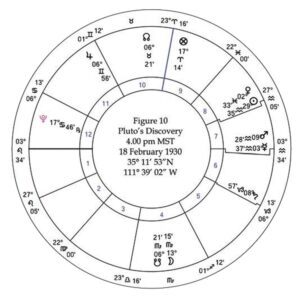
Astronomical Characteristics
Little is left to say that reflects on Pluto’s symbolism. As the furthest planet of the solar system, it remains the planet about which least is known. The new discoveries were constantly being labelled as ‘mysterious’ or ‘mystical’, but none more so than Pluto.
Political Events
After the Great War (First World War, 1914-1918), political changes had enormous effect on all that was to follow. Such important changes include the Versailles Peace Settlement of 1919, Gandhi’s domination of the Indian Congress in 1920, the forming of the Chinese Communist Party in 1921 and of the USSR in 1922, the ending of the Ottoman Empire in 1923 (which had endured since 1300), and Stalin’s succession of Lenin in 1924. Each bore heavily on world history, the repercussions still offering evidence of their impact to this day.
Pluto, though, is usually only associated with the Great Depression of 1929 to 1933, which led to the World Economic Depression of 1930, and which was directly related to the rise of Nazism (and other extreme political positions), Hitler, and the Second World War of 1939, to which Pluto is also connected.
As Pluto is linked with nuclear fission, it is linked to nuclear weapons and war; from this and its association with the Second World War, it deposed Mars as the ruler of these matters. This change of rulership was and is justified by suggesting that there are different kinds of war: there is war that simply kills people, and that which ‘annihilates’.120
The next outward planet from Neptune is Pluto, therefore this planet must obviously take position as the octave expression of Mars. Its main principle is annihilation, the logical continuation of the state of destruction. In war, a house or building is destroyed, but the rubble can remain. In course of time, if left exposed to the elements, the rubble reduces to smaller fragments and ultimately to powder. Then the four winds of heaven scatter it until finally not the tiniest particle is left. This is disintegration and finally annihilation – nothing – the ‘long term’ vibration of the planet Pluto,…121
Although Whitman is discussing a long-term breaking down of matter, this action has been extended to include mass destruction, an event that cannot, in Theosophist opinion, be encompassed by Mars.
Pluto’s discovery was also associated with racketeering of which there was a high incidence in the USA around 1930. This racketeering was associated with the Prohibition Era of 1920 to 1933, when the consumption of alcohol was banned in the USA. However, the first state law to be passed on the matter was in 1846, with the movement towards national temperance picking up momentum gradually, culminating in the national law of 1920. So, the trend began long before the discovery of Pluto.
Scientific Advances
Astrologers still aspired to Establishment acceptance, as their enthusiastic inclusion of Pluto in the system attests. They were keen, therefore, to link the scientific and technological discoveries to Pluto’s own discovery, as they had with the earlier discoveries. As with the period of Neptune’s discovery, though, these were in short supply, at least as far as popular awareness and interest was concerned. It was another example of the failure of their criteria to deal adequately with the problem of ascribing symbolism.
Pluto was linked to nuclear or atomic energy, and is said to rule nuclear weapons. The beginnings of atomic philosophy can be found in ancient Greece in the fifth century BC; Democritus of Abdera named the building blocks of matter ‘atomos’ (literally: ‘indivisible’). Modern atomic theory is founded in the work of Dalton and others of the early nineteenth century, while throughout that century further advances were made. As with the scientific advances attributed to Uranus and Neptune, the vital developmental processes were ignored. All that was taken notice of was that in 1932 the neutron was discovered and the atom was split.
Pluto Myth
There were many names proposed for the new discovery, but once its name had been decided upon, it posed a problem for astrologers. While they were prepared to accept the naming of planets by non-astrologers as meaningful coincidences, as previously mentioned, the name of Pluto had already been used.
Unfortunately astronomers have given it the unsuitable name of Pluto, a name which had already been given to a different hypothetical planet (ruling Cancer). To avoid confusion it is necessary in astrological circles to refer to the original Pluto as Wemyss-Pluto and to the Lowell planet as Lowell-Pluto.122
It failed to prevent confusion, however, and much of the symbolism of ‘Wemyss-Pluto’, including its rulership of Cancer, was passed on to the new discovery.
Their interpretations of the myths relating to Uranus and Neptune had become established and had proved convenient as psychological terminology was increasingly used in astrology. Thus it was, notwithstanding the unfortunate happenstance of the naming of Pluto, that the myth of the God of the Underworld was applied with enthusiasm. The name of this god is actually Hades and he ruled Tartarus. Fearing his wrath and revenge, he was usually called by his surname: Pluto (‘the Rich’) which referred to the riches of the earth.123 It is from this that the planet has gained association with great wealth, corporate wealth, and mines and underground activities. So, racketeering being linked to Pluto is supported through the notion of the criminal ‘underworld’.
Theosophical Doctrine
As has been shown above, adherence to the principle of ‘octave expressions’ continues to impress on the symbolism of the planets. The slow movement of the trans-Saturnians provides the evidence of their action in the larger world: Mercury represents the ordinary power of thought, but Uranus represents ‘individualized’ power of thought; Venus represents ordinary love, whilst Neptune represents ‘universal’ love; Mars represents destruction, Pluto represents complete destruction (which is what ‘annihilation’ means).124
Further comments can only be repetitive of those under the heads of Uranus and Neptune. The only changes that are in evidence are those made by individuals, and are only variations on the Theosophist theme of ‘octave expressions’.
Misunderstanding of the Astrological System
Under this heading we might include Pluto’s association with regeneration, since this is notably a quality given to hypothetical-Pluto and, as has been shown, was never intended to relate to the newly discovered planet.
The principles of annihilation and death have been taken from Mars and Saturn respectively. Rebirth, too, is given to Pluto, where this has always been associated with the Sun, whose motion through the heavens brings it to rebirth at every dawn. ‘Bringing to light’ is another phrase often used to explain Pluto’s action, and yet such an event is found through the good aspect (usually a trine) of the Sun and the Moon – the Lights. No other illumination can occur other than through the auspices of the Sun, whether actual or metaphoric.125
Once Pluto was announced as the ruler of Scorpio 8th house matters were associated with it because Scorpio is the eighth sign.126
In this respect, mention should be made about that Plutonic word ‘zeitgeist’. It means ‘spirit of the times’ and came to be associated with the trans-Saturnians as a group. The Theosophists used the slowness of their motion as representation of their ‘generational’ effect; several authors stating that they would have little effect on individuals, but that did not reduce the personal detail of their delineations.127 We might take this as an indication of their attempts to remove these planets from individual horoscopic analysis; if their effects were generational, there is little that can be said about one person. Such a position can be seen as a compromise: these planets were failing to live up to expectations in delineations, but could not be removed from the system, so they created another ‘escape clause’.
Conclusion
It is notable that with the increasing number of planets to be attended to by the astrologers, a greater freedom to deconstruct the original scheme was in evidence. In the earlier part of this paper, the fundamental astrological scheme was explained. That scheme is clearly built around the Sun and its apparent astronomical and physical characteristics. In this final assault on the ancient art, Pluto, as was explained earlier, is said to be more powerful than the Sun. In sacred terms, Pluto supplants God of whom the Sun is representative in most western cultures.
Only in the ‘scientific’ mood of the period of these discoveries could such profanity be countenanced, indeed, welcomed. We notice, too, that there are no challenges of a secular nature either, only attempts to keep the new system in place.
Comparisons
The words of Margaret Hone, the principal of the Faculty of Astrological Studies from 1954 to 1969, and who had great influence on the astrological community, should be examined:
…No definite decision has yet been made [on the rulerships of the new planets], but the ideas which are now coming to be accepted will be given. It may be that these new planets embody principles which are wide in their meaning and that they should not be confined to any one rulership, as in the traditional manner.
One way of speaking of them is that each is a ‘higher octave’ of one of the earlier known planets. It is as if they raise the thoughts and widen the outlook of humanity.128
This book was first published in 1951 and underwent four revisions, yet this stalwart of astrological education remained uncertain as to the symbolism of the new planets. The numbers of her students and readers can only be guessed, but her book went through fifteen reprints up to 1980, of which there were two in one year (1969). As with her predecessors, such doubts failed to restrict her from repeating the symbolism of the trans-Saturnians which was absorbed by many thousands of her readers and students.
The following lists of rulerships are drawn from a variety of late twentieth century works and comprise a convenient means of comparison with those rulerships prescribed by authors of the earlier period.129 The modern symbolism is listed under each planet and corresponds to its supposed source, shown in the first column. Although the theory of ‘octave expressions’ was part of Theosophical doctrine, it was advanced as a valid method through misunderstanding the astrological system and so has been included under the latter heading in the table. Under that heading, also, has been included the source of the symbolism, whether planet, house, or sign.
As psychology became prominent in astrological delineations, a change of language is in evidence, but whether it is phrased as a ‘higher type of group intuition’ or the ‘higher octave expression’, it means the same and the source is the same.130 Each of the three new planets was associated with the unconscious mind in one respect or another, and this derives from their, so-called, impenetrable natures. That impenetrability stemmed from the Theosophist astrologers’ inability to find accuracy in their interpretations, a condition which persists to this day.
Conclusion
This analysis of the symbolic accretions of the trans- Saturnians has, in some instances, been frustrated by the lack of logical method used by those promoting their use. The symbolic overlays are drawn from an increasingly spurious and superficial base. Personal opinion, doctrinal, and propagandist motives have confused the various issues. Indeed, the promoters themselves were unclear about how they were or should have been obtaining the natures and qualities of these planets. The symbolism of the new planets has been drawn from a narrowing foundation constructed largely from error and propaganda.
Increasingly, mythology, too, was relied upon, albeit selectively, and was extended to become the archetypes of Jungian psychology. Those who named the planets decided these myths, but this is given scant attention by astrologers; subsequent generations of astrologers having accepted it as meaningful coincidence. The evidence demonstrates quite clearly that the agenda was set for the Theosophists by the events and mood of their time, and yet, although the mood and trends have changed, the symbolism remains substantially unaltered to this day.
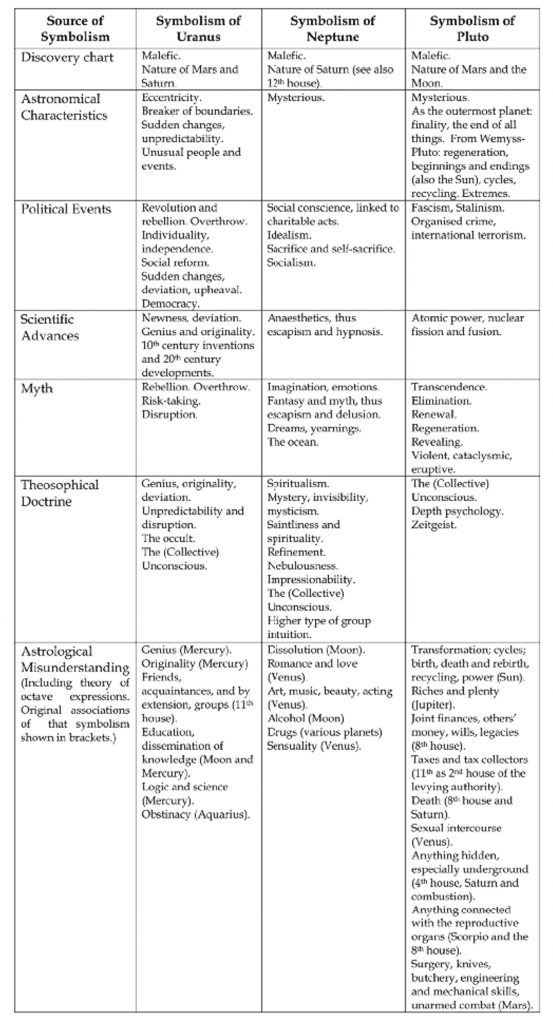
The symbolism of the new planets failed the astrologers’ own ‘scientific’ criteria. These planets did not produce the expected events or effects when applied to the astrological chart. If this ever caused doubt, it is not apparent in their writings. Convinced that the theory was correct, it was simply that the practice had not kept up apace, which would be rectified by further experiment. It was left to astrologers of the future to prove their theories, but as little of the symbolism has changed in the ensuing years, that proof has not been forthcoming.
The ‘esoteric’ astrology advanced by the Theosophists, was declared as superior to any other system or philosophy. From this, and in the confusion of astrological principles and techniques, the motivations of astrologers like Leo become clear. Manifestly, astrology was converted, deliberately and knowingly, to conform to Theosophist doctrine. The conversion of the astrological system was carried out with very little consideration given to the result – conviction of the probity of their actions fuelling their momentum. Indeed, anything was deemed better than the system it replaced. That doctrine was presented as Truth, and still forms the major part of astrological practice today, especially regarding the trans-Saturnian planets. Their conviction and their errors laid open this ancient and divine science to the illegitimate excesses which spawned the changeling system.
Before attempting to combine astrology with a personal philosophy, it is required that astrology’s own philosophy is understood. The difficulties of subjectivity, also, need to be addressed in the attempt to remain detached from the trends of a particular era. The effects of both from the period in question have been disproportionate and little has been done to correct the balance.
Under each point of analysis, the basis of the qualities of these planets has been shown to be insecure, and, subsequently, the Theosophist astrologers were forced to fall back to defensive positions. No point was ever proved astrologically, by experience, statistical evidence, or otherwise. Nevertheless, what those astrologers achieved was of no small importance: they convinced enough influential authors that their opinions were right. Those opinions have become established and many thousands of students have been taught them as proved facts.
Present-day astrologers repeat and replicate the symbolism laid down by the Theosophist astrologers. If an astrologer is not required to predict, in fact is often taught not to predict, then there is no requirement for accuracy. Likewise, there is no requirement for the planets to behave, astrologically speaking, in any predictable way. It is said that it is not possible to understand, or know, how the new planets will behave because they are ‘generational’ in effect, or they effect the deeper regions of our unconscious minds, thus not only can the astrologer not predict their actions, but the native has no way of registering that action. In other words, the astrological community is no further ahead with the symbolism of these planets, than were their forebears. In the early periods of their discoveries a few people argued against their astrological significance; in this the twenty-first century, the situation remains the same.
These authors were also exercised by the necessity to popularize astrology and impress the scientific community, however, whilst the former was achieved, astrology seems as far removed from acceptance by academia as ever it was, and for much the same reasons. Symbolism has been established on the flimsiest of grounds, and when it failed in practice, that symbolism was altered to accommodate such failure. It is unsurprising that the scientific establishment is not impressed to investigate astrology. The plausibility of those arguments is attractive only to those astrologers who have been trained in the ways of Theosophist astrology, and they are currently in the majority.
Examples are often provided for the efficacy of the trans- Saturnians in terms of their predictive capacities. This is quite apart from those who often quote the effects they have noticed personally. However, this evidence derives from those astrologers who are most firmly convinced of the symbolism: personal evidence comes from those same astrologers. Moreover, they have been taught in the modern school, which, as has been shown, is based on the Theosophist system. There is little new evidence to be obtained from such sources.
The symbolism of any chart, or group of charts, is multifarious. Identifying the ‘active’ planets requires the training and discipline which few astrologers have. The options available to the astrologer are varied, so it is easy to mistake one for another. Intuition might also be a factor in the successful prediction based on erroneous evidence. However, when a rigorous approach is applied, the new planets are superfluous. They cannot tell us anything new because there is nothing new to tell.
Astrologers should disabuse themselves of the certainty that the symbolism that has maintained regarding these planets had anything to do with astrological method, rectitude, or truth. It has maintained because those who promoted them had a vested interest in so doing, and their numbers and influence were overwhelming. Few were prepared to confront the jumble of sources when they failed in practice, and excuse was layered upon excuse, until astrologers of the present day no longer expect a logical approach. The New Age attitude predominates, and is just as disapproving of logic and common sense as it ever was. If the symbolism does not make sense, or if it fails in practice, it says that the practitioner should pay more heed to the spiritual model it sets.
The reader is left incredulous and confused. A raft of inaccuracies, illogicality, superficiality, and propagandist conveniences assails the intellect. Then, as now, such a non-conformist point of view is deemed non-astrological, or lacking in astrological understanding and borders on the heretical. It is said that there are certain qualities pertaining to the trans-Saturnians that are ‘unknowable’ to all but the most advanced souls. Yet, astrology was conceived as a method of understanding Divine Will; astrology is meant to be ‘known’. To say that we are not meant to know yet is an excuse for ignorance and pretended knowledge.
A return to the beginning is necessary because the primary questions remain unanswered: do the trans- Saturnian planets have astrological significance? Indeed, do they have to have astrological significance?
End.
97 Francis Moore, Vox Stellarum (London, 1865).
98 Leo, The Art of Synthesis, p. 112.
99 Leo, The Art of Synthesis, p. 112.
100 Sasha Fenton, The Planets (London, 1994).
101 Lilly, Christian Astrology, p. 59.
102 Charles and Suzy Harvey, Astrology: the only introduction you’ll ever need (London, 1999), p. 89.
103 ‘Obsession’ is a term used by Spiritualists to mean ‘possession by spirits of the dead’.
104 Leo, How to Judge a Nativity, p. 37.
105 Leo, The Art of Synthesis, p. x.
106 Leo, The Art of Synthesis, p. 113.
107 Robson, A Beginner’s Guide to Practical Astrology, p. 13.
108 Leo, The Art of Synthesis, p. 104.
109 Harrison, The Measure of Life, p. 19.
110 Leo, How to Judge a Nativity, p. 232.
111 Leo, The Art of Synthesis, p. 108.
112 Robson, A Beginner’s Guide to Practical Astrology, p. 113.
113 Leo, The Art of Synthesis, p. 117.
114 Leo, The Art of Synthesis, pp. 10 & 113. Leo also attributed hospitals to Neptune.
115 Brunhubner, Pluto.
116 Harrison, The Measure of Life, pp. 15 & 25.
117 Maurice Wemyss and Isabelle M. Pagan.
118 Maurice Wemyss, Wheel of Life or Scientific Astrology, (London 1927–1929 & Vol. 5 post-1945), p. 117.
119 Isabelle Pagan, From Pioneer to Poet or the Twelve Great Gates (London, 1926, 2nd ed.).
120 Sepharial, The Manual of Astrology, p. 16.
121 Edward W. Whitman, Pluto the Transformer and Annihilator: The Planet of Fission in the Twelve Houses of the Horoscope. (Self-published, London. The publication date is uncertain, but according to the text it appears that the booklet was written in the 1950s), p. 7.
122 Leo, The Art of Synthesis, p. 123. Alan Leo died in 1917, but his books continued to be revised and published under his name.
123 Grimal, The Dictionary of Classical Mythology.
124 Whitman, Pluto the Transformer, p. 7.
125 For more on this see, ‘The Sun in the Traditional System’,NCGR Geocosmic Journal, Winter 2010, pp. 64-66.
126 Harrison, The Measure of Life, p. 28.
127 For example, Leo, Casting the Horoscope (London, 1933; first published as Astrology For All Part II, London 1904), p. 199; Leo, How to Judge a Nativity, pp. 66.
128 Margaret Hone, The Modern Text Book of Astrology: Revised Edition (Romford, 1980), pp. 32-33.
129 See separate bibliography in the Appendix.
130 Liz Greene, The Outer Planets and Their Cycles: The Astrology of the Collective (California, 1996).
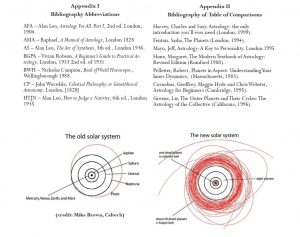
翻譯:Hueimin Lin/Julie Ho|編審:Maki S. Zhai
本文經作者授權翻譯刊登,其翻譯著作權歸屬 智者星象學院所有,歡迎分享本網頁連結給你的朋友,但請勿直接轉載內容。
This article is translated and published with the authorization of the author, and the copyright of this translation belongs to Astro Mages.org.
You may share the link to this page with your friends, but please do not directly reprint the content.





